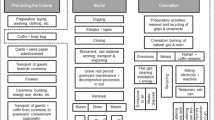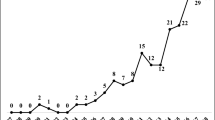Abstract
Sustainability impact assessment (SIA) is a prospective, integrated assessment approach for potential impacts of policy actions. Multi-criteria analysis (MCA) can be used to facilitate a multi-indicator evaluation in this framework in order to foster rational and transparent decision-making processes for SIA. Based on the outputs of the EFORWOOD project, this paper presents an exploratory MCA to a regional forest-wood chain (FWC) in Baden–Württemberg. This assessment is based on a set of sustainability indicators at process level for a baseline year 2005, reference futures ‘A1’ and ‘B2’ following the definition of the IPCC and a bio-energy scenario implanted into the reference future ‘A1’. The indicator values were calculated by the process tool ToSIA. It is demonstrated how time steps for parts of the regional FWC (forest management, harvest and transport to the mill gate) can be evaluated, as well as the outcomes of different scenarios for a time period. For this purpose, a novel software tool, ToSIA-MCA, is used to calculate relative sustainability impact rating (SIR) based on a PROMETHEE II algorithm. Further, we performed uncertainty analysis to test the stability of ranking results in the absence of real preference information with regard to uncertainty in indicator data. By comparing different indicator weighting patterns, the sensitivity of SIR calculation was further tested. The exploratory MCA outcomes are critically evaluated against the background of assumptions, and data used in the regional case, and an outlook is given on the importance to gain stronger stakeholder involvement in real-life applications.




Similar content being viewed by others
References
Belton V, Stewart TJ (2002) Multiple criteria decision analysis: an integrated approach. Kluwer Academic Publishers, Dordrecht
Bouyssou D, Marchant T, Pirlot M, Tsoukias A, Vincke P (2006) Evaluation and decision models with multiple criteria. Stepping stones for the analyst, Springer
Brans JP, Vincke P, Mareschal B (1986) How to select and how to rank projects: the PROMETHEE method. Eur J Oper Res 24:228–238
Brouwer R, Van Ek R (2004) Integrated ecological, economic and social impact assessment of alternative flood control policies in the Netherlands. Ecol Econ 50:1–21
CEC (2002) Communication from the Commission on impact assessment. COM(2002). 276 final. Commission of the European Communities (CEC), Brussels
Colorni A, Laniado E, Muratori S (1999) Decision support systems for environmental impact assessment of transport infrastructures. Transp Res: Part D: Transport Environ 4:1–11
Eforwood (2007) Protocol for the evaluation of Multi-Criteria Analysis methods for use within EFORWOOD. In: Wolfslehner B (ed) Project deliverable, p 38
Eforwood (2008a) Manual for data collection for Regional and European cases. In: Berg S (ed) Project deliverable, p 110
Eforwood (2008b) Deliverable PD3.4.5 “Development and selection of M3-specific key scenarios for ToSIA at case study level”. In: Fischbach J (ed) Project deliverable, p 5
Eforwood (2010) Deliverable PD3.0.3 case study “Baden-Württemberg”. In: Brüchert F (ed) Final report. p 61
Esteves AM (2008) Evaluating community investments in the mining sector using multi-criteria decision analysis to integrate SIA with business planning. Environ Impact Assess Rev 28:338–348
Gamper CD, Turcanu C (2007) On the governmental use of multi-criteria analysis. Ecol Econ 62:298–307
Gasparatos A, El-Haram M, Horner M (2008) A critical review of reductionist approaches for assessing the progress towards sustainability. Environ Impact Assess Rev 28:286–311
George C, Kirkpatrick C (2003) Sustainability impact assessment of world trade negotiations: current practice and lessons for further development. Institute for Development Policy and Management, University of Manchester, UK. Conference paper, new directions in impact assessment for development, University of Manchester
Hermann BG, Kroeze C, Jawjit W (2007) Assessing environmental performance by combining life cycle assessment, multi-criteria analysis and environmental performance indicators. J Clean Prod 15:1787–1796
Huth A, Drechsler M, Köhler P (2005) Using multicriteria decision analysis and a forest growth model to assess impacts of tree harvesting in Dipterocarp lowland rain forests. For Ecol Manage 207:215–232
IPCC (2000) Special report: emissions scenarios. International Panel on Climate Change, p 27
Kirkpatrick C, Lee N (2002) Further development of the methodology for a sustainability impact assessment of proposed WTO negotiations. Final Report to the European Commission. Manchester/IDPM, University of Manchester
Lee N (2006) Bridging the gap between theory and practice in integrated assessment. Environ Impact Assess Rev 26:57–78
Lindner M, Suominen T, Palosuo T, Garcia-Gonzalo J, Verweij P, Zudin S, Päivinen R (2010) ToSIA–a tool for sustainability impact assessment of forest-wood-chains. Ecol Modell 221:2197–2205
Lindner M, Werhahn-Mees W, Suominen T, Vötter D, Zudin S, Pekkanen M, Päivinen R, Roubalova M, Kneblik P, Brüchert F, Valinger E, Guinard L, Pizzirani S (2011) Conducting sustainability impact assessments of forestry-wood chains: examples of ToSIA applications. Eur J Forest Res. doi:10.1007/s10342-011-0483-7
Ness B, Urbel-Piirsalu E, Anderberg S, Olsson L (2007) Categorising tools for sustainability assessment. Ecol Econ 60:498–508
Nilsson M, Jordan A, Turnpenny J, Hertin J, Nykvist B, Russel D (2008) The use and non-use of policy appraisal tools in public policy making: an analysis of three European countries and the European Union. Policy Sci 41:335–355
Paracchini ML, Pacini C, Jones MJM, Pérez-Soba M (2011) An aggregation framework to link indicators associated with multifunctional land use to the stakeholder evaluation of policy options. Ecol Indic 11:71–80
Pülzl H, Prokofieva I, Berg S, Rametsteiner E, Aggestam F, Wolfslehner B (this issue) The indicator development process in EFORWOOD. Eur J For Res
Rabl A, Holland M (2008) Environmental assessment framework for policy applications: life cycle assessment, external costs and multi-criteria analysis. J Environ Plan Manage 51:81–105
Ramanathan R (2001) A note on the use of the analytic hierarchy process for environmental impact assessment. J Environ Manage 63:27–35
Rametsteiner E, Pülzl H, Puustjärvi E (2006) Draft FWC indicator set: detailed review of existing sustainability indicator concepts and sustainability indicator sets of relevance for the FWC, review of potential indicators for selection and their assessment. EFORWOOD Project, Deliverable D1.1.1., BOKU University, Austria
Sadok W, Angevin F, Bergez JE, Bockstaller C, Colomb B, Guichard L, Reau R, Doré T (2008) Ex ante assessment of the sustainability of alternative cropping systems: implications for using multi-criteria decision-aid methods. A review. Agron Sustain Dev 28:163–174
Solberg B, Moiseyev A, Kalliom AMI (2003) Economic impacts of accelerating forest growth in Europe. Forest Pol Econ 5:157–171
StaLA BW (2007) Statistisches Landesamt Baden-Württemberg (2007) http://www.statistik.baden-wuerttemberg.de/Landwirtschaft/Landesdaten/LRt0714.asp. Accessed 10 Aug 2007
WCED (1987) Our common future. World commission on environment and development. Oxford University Press, Oxford
Wolfslehner B, Seidl R (2010) Harnessing ecosystem models and multi-criteria decision analysis for the support of forest management. Environ Manage 46:850–861
Wolfslehner B, Vacik H (2008) Evaluating sustainable forest management strategies with the analytic network process in a pressure-state-response-framework. J Environ Manage 88:1–10
Wolfslehner B, Vacik H, Lexer MJ (2005) Application of the analytic network process in multi-criteria analysis of sustainable forest management. For Ecol Manage 207:157–170
Acknowledgments
The authors would like to thank all project partners who put efforts in process definition, data collection and calculation of indicators for the partial FWCs in the BW case used for this investigation, namely Torsten Bensemann, Volker Bölle, Philipp Duncker, Udo H. Sauter, Heinrich Spiecker, Philipp Weinert, Jürgen Zell and Katarzyna Zielewska at Freiburg University and FVA Baden–Württemberg.
Conflict of interest
This work was funded by the European Community’s Sixth Framework Programme within the Integrated Project ‘EFORWOOD’, contract no. 518128.
Author information
Authors and Affiliations
Corresponding author
Additional information
Communicated by K. Rosen.
This article originates from the context of the EFORWOOD final conference, 23–24 September 2009, Uppsala, Sweden. EFORWOOD––Sustainability Impact Assessment of Forestry-wood Chains. The project was supported by the European Commission.
Rights and permissions
About this article
Cite this article
Wolfslehner, B., Brüchert, F., Fischbach, J. et al. Exploratory multi-criteria analysis in sustainability impact assessment of forest-wood chains: the example of a regional case study in Baden–Württemberg. Eur J Forest Res 131, 47–56 (2012). https://doi.org/10.1007/s10342-011-0499-z
Received:
Revised:
Accepted:
Published:
Issue Date:
DOI: https://doi.org/10.1007/s10342-011-0499-z




